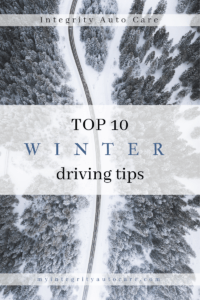
Number 10: Slow down
Those warnings about decreasing your speed when roads are wet, snow packed or icy shouldn’t be dismissed as the suggestions of finger-wagging octogenarians who have seemingly forgotten what the gas pedal does. There’s this little thing called physics that tells us that the faster you go, the farther you’re apt to slide if you hit a slick spot. Really. Ask Google. We are not making this up.
Number 9: Speaking of physics, SUVs aren’t immune to it
Suburbans and Escalades can drive over a lot of things, but not the laws of science. In fact, if you start to slide in a giant sports-utility vehicle, the extra size and weight are apt to get you in trouble faster than if you were piloting a Mini Cooper. And that’s not to mention the issues some SUVs have with rolling over and/or flipping. While you may feel like you own the road one minute, you may be on your top a minute or two later.
Number 8: Slamming on your brakes can be totally pointless
Trying to mash your brake pedal through the floorboards only works if you’re in a 1960’s cartoon, especially on snowy pavement where you’ve got little to no traction. If you’ve got anti-lock brakes, steady pressure works. If you have standard brakes, pump them. And do it gently rather than pretending you’re a two year old throwing a temper tantrum… because your car may end up too crinkled up to drive.
Number 7: Black ice is actually a thing
So you look at the roads ahead and don’t see any snow on them even though there’s been precipitation recently and it’s freezing outside. Time to burn rubber!? Wrong. There’s a good chance the surface is covered with a thin sheet of ice capable of turning your car into the equivalent of a hockey puck. Not a good idea.
Number 6: Signs that say “Watch for ICE on Bridge”
It’s not a myth: Bridges and overpasses are frequently icier than the roadway on either side of them. For that reason, executing a lane change or traffic maneuver on a bridge that might work fine on the rest of the interstate could end with you getting a face-full of air bag.
Number 5: Get low
When it’s snowing like crazy and your visibility isn’t good at all, you’re going to be tempted to switch on your brights… and after you do, you’ll be blinded by the light reflecting off the snow and bouncing right back at you. Use the low beams or fog lamps, and feel free to leave them on until you get to your destination…which you’ll have a lot better chance of reaching if you haven’t blinded yourself by flipping on your high beams.
Number 4: Sudden turns can turn into sudden wipe-outs
In best-case scenarios, you actually know where you’re going… meaning you know when you need to turn and can start doing it early, rather than at the last minute. So when the weather’s dicey, round your corners… unless you’d rather run into them.
Number 3: Be ready for a skid
There continues to be debate about whether steering into a skid is the right thing to do or the key ingredient to an unintended 360. But we defer to the MasterDrive instructor. His advice is simple and easy to remember: “Look where you want to go and steer in that direction.”
Number 2: It’s actually important to be able to see where you’re going
On days when it’s snowing sideways, visibility is often more figurative than literal… and when that’s the case, you can’t continue to drive as you would on a sunny day, when your knowledge of your usual route makes the process almost automatic. Don’t take anything for granted, or you’ll be sorry…as will everyone else around you.
Number 1: Be patient
When the road conditions are lousy, it’s going to take you longer to get where you want to go. So, give yourself a little more time. Or don’t, and be cool about getting there a few minutes after you’d planned. A snowstorm is a great excuse for showing up late, and Coloradans are generally very understanding when it happens. You’ll realize that after you’ve been here for a awhile, if you haven’t already.

